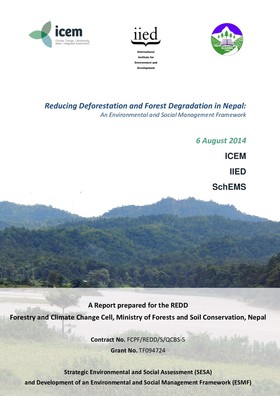Reducing Deforestation and Forest Degradation in Nepal: An Environmental and Social Management Framework

Nepalese people are highly dependent on forests and forest products to fulfill energy demands and for timber for construction and maintenance of houses and buildings. The main reasons for the conversion of forest areas are encroachment for resettlement/agriculture, and acquisition of forest area for infrastructure development including road expansion.
The deforestation and degradation of forest accounts for a significant amount of carbon dioxide released to the atmosphere through the combustion of forest biomass and decomposition of remaining plant materials and soil carbon. Research carried out by the IPCC has revealed that almost 20% of carbon dioxide released to the atmosphere comes from global forest degradation and deforestation. As a result, attention has focused on the need to reduce emissions from deforestation and forest degradation, popularly known as REDD.
In September 2013, the REDD Forestry and Climate Change Cell (REDD Cell) of the Government of Nepal’s Ministry of Forest and Soil Conservation (MFSC) commissioned a Strategic Environmental and Social Assessment (SESA) of the REDD+ Strategy together with an accompanying Environmental and Social Management Framework (ESMF). It was undertaken by IIED in collaboration with the International Centre for Environmental Management (ICEM) and the School of Environmental Science and Management (SchEMS), Nepal. The work was conducted by an international team led by IIED’s Barry Dalal-Clayton and also included IIED’s Simon Milledge and Isilda Nhantumbo.
The overall objective of this integrated assessment was to identify opportunities to mitigate environmental and socioeconomic risks under the implementation of a REDD+ mechanism in Nepal. The SESA was also to identify where REDD+ could improve development activities and other environmental measures adopted to combat climate change.
Follow the 'More information' link below for the related a Strategic Environmental and Social Assessment (SESA) report and more REDD+ publications and project background:
Cite this publication
Available at https://www.iied.org/g03822






